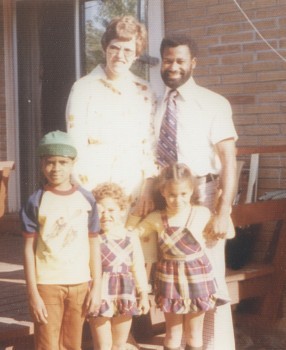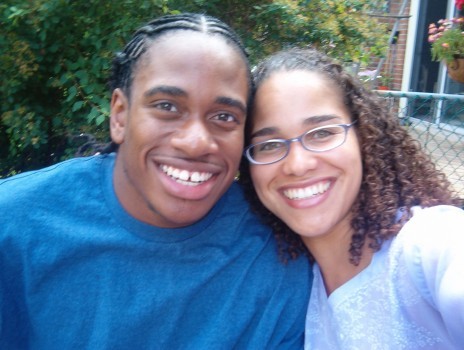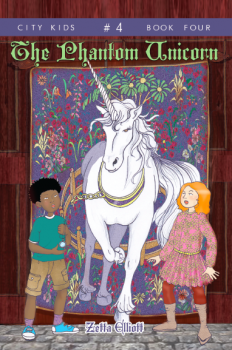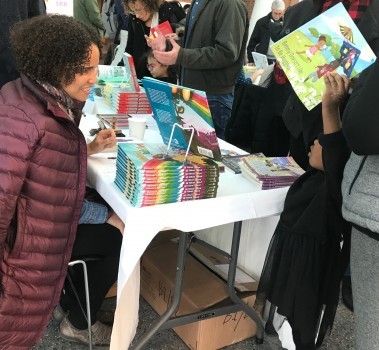all in the family
 Last month I visited Prof. Roni Natov’s class at Brooklyn College to talk about the representation of families in my books for young readers. I come from a “non-traditional” family. My parents were a mixed-race couple; my mother identifies as White, though she has African American ancestors. Their marriage lasted from 1967 to 1981, and during that time they adopted my older brother Denzil; he was my father’s first cousin and was “brought up” from the Caribbean to have “a better life” as part of our nuclear family. But the adoption was a disaster; my brother was physically abused by my father—who had been abused as a boy himself. Denzil repeatedly ran away and was finally returned to his birth mother (my father’s aunt) in the Caribbean. My parents split up a couple of years later when my father cheated on my mother with a college sweetheart and from that point onward, my family became something very far from the norm. My older sister and I moved with my mother into a townhouse just
Last month I visited Prof. Roni Natov’s class at Brooklyn College to talk about the representation of families in my books for young readers. I come from a “non-traditional” family. My parents were a mixed-race couple; my mother identifies as White, though she has African American ancestors. Their marriage lasted from 1967 to 1981, and during that time they adopted my older brother Denzil; he was my father’s first cousin and was “brought up” from the Caribbean to have “a better life” as part of our nuclear family. But the adoption was a disaster; my brother was physically abused by my father—who had been abused as a boy himself. Denzil repeatedly ran away and was finally returned to his birth mother (my father’s aunt) in the Caribbean. My parents split up a couple of years later when my father cheated on my mother with a college sweetheart and from that point onward, my family became something very far from the norm. My older sister and I moved with my mother into a townhouse just  inside Toronto’s city limits, and we saw our father on weekends. After a string of girlfriends—most of whom had kids of their own—my father settled down with a Jamaican woman; she had two kids from previous relationships, and with my father she had two more kids. So I went from being the baby of the family to having younger step-siblings and half-siblings. In high school I was occasionally called “Cosby kid.” I certainly didn’t look like Lisa Bonet, but for my White friends—and for me, as well—that show was the first time they’d seen a large Black family whose members had varying skin tones. Of course, in my family, it wasn’t just about genetics; we looked different because we were a collage, different people cut and pasted into different
inside Toronto’s city limits, and we saw our father on weekends. After a string of girlfriends—most of whom had kids of their own—my father settled down with a Jamaican woman; she had two kids from previous relationships, and with my father she had two more kids. So I went from being the baby of the family to having younger step-siblings and half-siblings. In high school I was occasionally called “Cosby kid.” I certainly didn’t look like Lisa Bonet, but for my White friends—and for me, as well—that show was the first time they’d seen a large Black family whose members had varying skin tones. Of course, in my family, it wasn’t just about genetics; we looked different because we were a collage, different people cut and pasted into different  configurations in different moments. When my father left for the US, I stayed in touch with my half-siblings but lost touch with my step-siblings. My dad married again and I’ve just recently reconnected with my older stepsister from that marriage (which ended in divorce a few years later). There were certainly times in my life when I was embarrassed by my unwieldy, unusual family; I dreaded having to explain just how I was related to each sibling, why certain ones no longer spoke to me, why we didn’t look alike. But when I presented on Black families at Brooklyn College last month, I talked about how centuries of enslavement impacted the Black family, leading to innovation and improvisation and a more progressive understanding of kinship. We aren’t bound by blood to every person we consider family. And sometimes the folks who share our DNA aren’t worth keeping close. I try to represent the complexity of Black families in my books for young readers. At the Brooklyn Museum Children’s Book Fair last weekend, a Black woman picked up The Phantom Unicorn and read the first two lines of the summary on the
configurations in different moments. When my father left for the US, I stayed in touch with my half-siblings but lost touch with my step-siblings. My dad married again and I’ve just recently reconnected with my older stepsister from that marriage (which ended in divorce a few years later). There were certainly times in my life when I was embarrassed by my unwieldy, unusual family; I dreaded having to explain just how I was related to each sibling, why certain ones no longer spoke to me, why we didn’t look alike. But when I presented on Black families at Brooklyn College last month, I talked about how centuries of enslavement impacted the Black family, leading to innovation and improvisation and a more progressive understanding of kinship. We aren’t bound by blood to every person we consider family. And sometimes the folks who share our DNA aren’t worth keeping close. I try to represent the complexity of Black families in my books for young readers. At the Brooklyn Museum Children’s Book Fair last weekend, a Black woman picked up The Phantom Unicorn and read the first two lines of the summary on the  back cover: “A boy with two mothers? I definitely need this book!” A lot of kids don’t get to see their family represented in a book, and I try to represent different family configurations in my stories. But will those books reach the kids who need them? I’m always struck by members of the kid lit community who only acknowledge the books I’ve published traditionally. To them, my indie titles don’t count. They know racism in publishing is real, but they nonetheless refuse to recognize that quality books could come through other channels. To me, that’s like looking at my family and saying Denzil isn’t my “real” brother because he’s adopted; or that I have one sister rather than half a dozen because only the biological children from my parents’ first marriage count. My indie titles sold really well at the museum book fair and as soon as I finish The Dragon Thief, I’ll start planning a launch party for The Phantom Unicorn. At the end of the day, the people who are looking for me find me. I had several educators come up to my table and thank me for writing Benny Doesn’t Like to Be Hugged. It wasn’t available for purchase (that little girl desperately wanted to take my only copy home with her) but at least more people now know it exists. And we’ve only got one review so far, but it’s stellar. I received two invitations to present in 2018 since launching The Phantom Unicorn yesterday, and that’s encouraging. Families like mine are no longer the exception—we’re becoming the norm. Hopefully more gatekeepers will recognize that fact and embrace stories that reflect the “new” reality.
back cover: “A boy with two mothers? I definitely need this book!” A lot of kids don’t get to see their family represented in a book, and I try to represent different family configurations in my stories. But will those books reach the kids who need them? I’m always struck by members of the kid lit community who only acknowledge the books I’ve published traditionally. To them, my indie titles don’t count. They know racism in publishing is real, but they nonetheless refuse to recognize that quality books could come through other channels. To me, that’s like looking at my family and saying Denzil isn’t my “real” brother because he’s adopted; or that I have one sister rather than half a dozen because only the biological children from my parents’ first marriage count. My indie titles sold really well at the museum book fair and as soon as I finish The Dragon Thief, I’ll start planning a launch party for The Phantom Unicorn. At the end of the day, the people who are looking for me find me. I had several educators come up to my table and thank me for writing Benny Doesn’t Like to Be Hugged. It wasn’t available for purchase (that little girl desperately wanted to take my only copy home with her) but at least more people now know it exists. And we’ve only got one review so far, but it’s stellar. I received two invitations to present in 2018 since launching The Phantom Unicorn yesterday, and that’s encouraging. Families like mine are no longer the exception—we’re becoming the norm. Hopefully more gatekeepers will recognize that fact and embrace stories that reflect the “new” reality.



